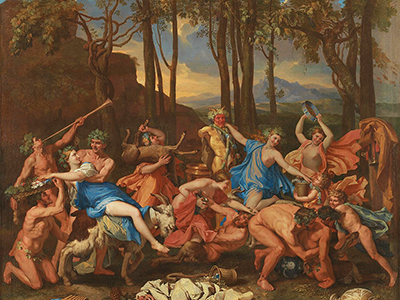Nicolas Poussin is famed for his wonderful allegorical paintings in which incidents and events of the past, from mythology and from Biblical tales are depicted with painstaking attention to detail: it is almost always easy to read the expressions of the subjects to understand what is going on in the image, even without knowing the back-story first.
This is one such painting and it is clear that what is going on is something sexual and clearly enjoyable to all, even the disturbingly young figure to the right of the image, who is, one hopes, merely one of Pan's ethereal helpers and not a human child. The painting blurs many boundaries, with female sexuality and enjoyment of such clearly shown, alongside the aforementioned child, and what can only be presumed to be some sort of congress with the several goats who feature in the scene.
The more one examines the painting: several characters appear to be thoroughly over-excited, there is a lot of casual nudity, and there are issues that would be horrific today, but that were also very much frowned upon both in Pan's time (around 1200BC to circa 20AD) and in Poussin's, (the late 1500s to the mid-to-late 1600s). The connection with goats and promiscuity is a lasting one, and Poussin would have clearly understood what he was implying by including so many of the animals in the piece: there seems to be a shameless mix of woman, man, goat and satyr, all bent on enjoying the moment, scantily clad and surrounded by natural features such as trees, flowers, fruit and garlands of leaves.
In the foreground, there lies a mask and an abandoned robe together with a shepherd's crook. This perhaps sums up Pan's Victory as declaimed in the title: he has succeeded in creating pandemonium (the word, along with panic) is named for the effect he had on mere mortals. It would appear that he has played the part of the shepherd to great success, gathering about him a group of supporters and adherents. Once they were sufficiently under his spell, Pan has dropped his disguise and worked his rough natural magic on them so that they too have dropped their nurturing guises to indulge their base appetites for sex, food, drink and intimacy.
The painting is not a comfortable one, but it does bear examination with more and more details presenting themselves for consideration the longer one looks. Whatever his intentions, Poussin has made a statement about human nature that might resonate with some viewers! The painting, large at 136cm by 146cm, is in oil on canvas, and can currently be found in Room 29 of the National Gallery in London.




